#marine fossil shell
Explore tagged Tumblr posts
Photo

Fossil Pectin Shell – Eocene Epoch, Clallam Bay Washington USA, Genuine Bivalve Specimen
A well-preserved Fossil Pectin Shell (scallop) from the Eocene Epoch, approximately 40–50 million years old. This specimen was collected from the Clallam Formation near Clallam Bay, Washington State, USA, a site known for producing beautifully preserved marine invertebrate fossils from the early Paleogene period.
Pectin shells belong to the family Pectinidae, a group of marine bivalves distinguished by their fan-shaped, radially ribbed shells. This fossil showcases the elegant symmetry and surface ribbing typical of this family, preserved in fine-grained sediment.
Fossil Type: Bivalve (Scallop) Shell
Geological Age: Eocene – Ypresian to Lutetian Stages
Formation: Clallam Formation
Depositional Environment: The Clallam Formation was deposited in a shallow marine environment along a continental shelf. Calm conditions and fine silts contributed to the exceptional preservation of molluscs, echinoderms, and other invertebrates in the fossil record.
Morphological Features:
Distinct fan-shaped shell outline
Radiating ribs across the surface
Some specimens retain hinge or growth lines
Notable:
Classic marine invertebrate from the Eocene of the Pacific Northwest
Ideal for educational displays, fossil collectors, or palaeontology enthusiasts
The photograph shows the exact item offered for sale
Authenticity: All of our fossils are 100% genuine natural specimens and come with a Certificate of Authenticity. Please refer to the scale image for exact size – each square or cube equals 1cm.
This Eocene Pectin shell from Clallam Bay offers a glimpse into the marine ecosystems of ancient Washington. A beautiful and scientifically valuable specimen for any fossil enthusiast.
#Pectin fossil#fossil bivalve shell#Eocene fossil USA#Clallam Bay fossil#scallop fossil#marine fossil shell#Washington State fossil#Pectinidae fossil#genuine fossil specimen#collector fossil shell#Eocene bivalve#fossil clam#authentic fossil scallop
0 notes
Text
Ehehehehee enjoy this VERY small portion of my fossil collection all collected in maine

















If anyone want to know how old these are here’s a map of maine so you can guess
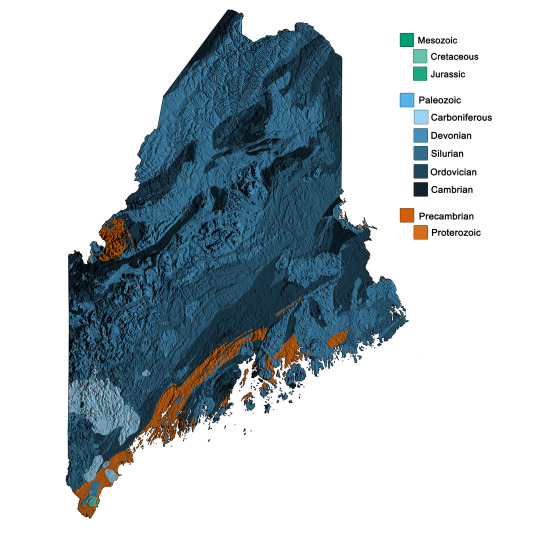
I go ‘rock picking’ with my mom and we basically climb around on piles of rocks in gravel pits and steal the fossils so they don’t get destroyed by gravel pit machinery. I don’t like put parties but I sure as hell love rock picking in pits!!
I don’t give a shit nor do I know if this is legal to do so I can’t advise on whether or not you should also go rock picking you may get into trouble you may not WHO KNOWS!!
#Maine#fossils#maine fossils#Marine fossils#Paleontology#maine paleontology#fossil collection#Cool fossils#Shell fossils
7 notes
·
View notes
Text
Oyster Shell Vol. 4
Introducing the Oyster Shell Vol. 4, a beautifully crafted 3D printable model designed to add elegance and charm to any space. Visit here to Download: https://www.artstation.com/a/42510193 This unique piece, rendered in a vibrant red color, is perfect for decorative purposes and makes an exquisite gift item.







#3d#3d model#blender3d#3d printing#cults3d.com#tumblr milestone#youtube#art#3d render#3dmodeling#oysters#shell#fossils#marine animal
4 notes
·
View notes
Text




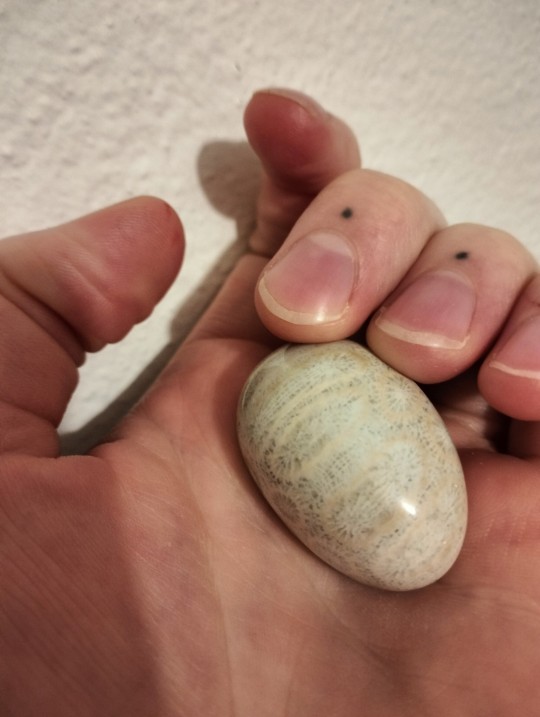
Part of my collections colour pallet.
3 notes
·
View notes
Photo
beigehalo: Sand, under a 250x microscope.

#mineral#minerals#sand#salt#coral#corals#shell#shells#fossil#fossils#microscopic#microscope#beach#beaches#ocean#sea#aquatic#marine#nature
345K notes
·
View notes
Photo










(via "The Marine Spiral - A Tribute to the Nautilus Ammonite" Metal Print for Sale by OLena Art ❣️) "Luminous Depths." This stunning artwork showcases the detailed structure of an ammonite fossil, capturing its spiraled shell in all its glory. The warm oranges and browns at the center transition seamlessly into cooler blues and purples at the edges, creating a mesmerizing display of color gradients. The luminescent quality of the shell gives it a lifelike appearance, while the deep blue background makes the fossil truly pop. Each chamber is meticulously defined, revealing the fossil's natural geometric patterns and beauty. Dive into the depths of history with this captivating piece.
#findyourthing#redbubble#ammonite fossil marine creature Luminous Depths detailed structure spiraled shell color gradients luminescent deep blue background geometric
1 note
·
View note
Text

THE OLDEST PREDATOR-PREY ARMS RACE UNCOVERED IN CAMBRIAN FOSSILS
A recent fossil study has revealed the oldest known evidence of an evolutionary arms race between predators and prey, dating back 517 million years to the Cambrian oceans. Researchers examined fossilized shells of Lapworthella fasciculata, a small shelled animal, and found that over 200 of them had holes likely caused by an unknown drilling predator. This predator, possibly a mollusc or soft-bodied worm, was able to penetrate the prey’s defences, triggering an adaptive response.
Interestingly, over time the shells of L. fasciculata became thicker, suggesting that the animal developed mechanisms to reinforce its shell and better withstand attacks. As shell thickness increased, so did the number of perforations, indicating that the predator also improved its ability to drill through the prey’s defences. This back-and-forth adaptation is a clear example of an evolutionary arms race, where each species evolves in response to the other in a constant battle for survival.
This discovery is crucial for understanding how predator-prey interactions drove early animal evolution, and supports the idea that predation played a key role in the diversification of biomineralizing organisms during the Cambrian explosion. Published in Current Biology, the study offers a fascinating glimpse into marine life over 500 million years ago and highlights how quickly evolutionary changes can emerge under environmental pressures.
main image: Examples of Lapworthella fasciculata shells (under scanning electron microscope) from Flinders Ranges, South Australia, showing holes made by a drilling predator. Scale bars represent 200 micrometres (0.2 mm).
Reference: Bicknell et al., 2025. Adaptive responses in Cambrian predator and prey highlight the arms race during the rise of animals. Current Biology.
599 notes
·
View notes
Text

The distinctive pinhole eyes, leathery hood, and numerous tentacles of modern nautiluses were traditionally thought to represent the "primitive" ancestral state of early shelled cephalopods – but genetic studies have found that that nautiluses actually secondarily lost the genes for building lensed eyes, and their embryological development shows the initial formation of ten arm buds (similar to those of coeloids) with their hood appearing to be created via fusing some of the many tentacles that form later.
There's a Cretaceous nautilidan fossil that preserves soft tissue impressions of what appear to be pinhole eyes and possibly a remnant of a hood, so we know these modern-style nautilus features were well-established by the late Mesozoic. But for much more ancient Paleozoic members of the lineage… we can potentially get more speculative.
So, here's an example reconstructed with un-nautilus-like soft parts.
Solenochilus springeri was a nautilidan that lived during the Late Carboniferous, around 320 million years ago, in shallow tropical marine waters covering what is now Arkansas, USA.
Up to about 20cm in diameter, (~8"), its shell featured long sideways spines which may have served as a defense against predators – or possibly as a display feature since they only developed upon reaching maturity.
———
NixIllustration.com | Tumblr | Patreon
References:
Anthony, Franz. "500 million years of cephalopod fossils" Earth Archives, 19 Feb. 2018, https://eartharchives.org/articles/500-million-years-of-cephalopod-fossils/index.html
Klug, Christian, et al. "Preservation of nautilid soft parts inside and outside the conch interpreted as central nervous system, eyes, and renal concrements from the Lebanese Cenomanian." Swiss Journal of Palaeontology 140 (2021): 1-11. https://doi.org/10.1186/s13358-021-00229-9
Korn, Dieter, and Christian Klug. "Early Carboniferous coiled nautiloids from the Anti-Atlas (Morocco)." European Journal of Taxonomy 885 (2023): 156-194. https://doi.org/10.5852/ejt.2023.885.2199
Kröger, Björn, Jakob Vinther, and Dirk Fuchs. "Cephalopod origin and evolution: a congruent picture emerging from fossils, development and molecules: extant cephalopods are younger than previously realised and were under major selection to become agile, shell‐less predators." BioEssays 33.8 (2011): 602-613. https://doi.org/10.1002/bies.201100001
Mikesh, David L., and Brian F. Glenister. "Solenochilus Springeri (White & St. John, 1868) from the Pennsylvanian of Southern Iowa." Proceedings of the Iowa Academy of Science. Vol. 73. No. 1. 1966. https://scholarworks.uni.edu/pias/vol73/iss1/39/
Shchedukhin, A. Yu. "New Species of the Genus Acanthonautilus (Solenochilidae, Nautilida) from the Early Permian Shakhtau Reef (Cis-Urals)." Paleontological Journal 58.5 (2024): 506-515. https://www.researchgate.net/publication/384922837_New_Species_of_the_Genus_Acanthonautilus_Solenochilidae_Nautilida_from_the_Early_Permian_Shakhtau_Reef_Cis-Urals
Wikipedia contributors. “Nautilida” Wikipedia, 26 Nov. 2024, https://en.wikipedia.org/wiki/Nautilida
Wikipedia contributors. “Solenochilus” Wikipedia, 28 Apr. 2022, https://en.wikipedia.org/wiki/Solenochilus
#science illustration#paleontology#paleoart#palaeoblr#solenochilus#solenochilidae#nautilida#nautiloid#cephalopod#mollusc#invertebrate#art#doing the inverse of all those ammonite reconstructions that make them look like nautiluses
220 notes
·
View notes
Text




.。*♡゚Who is Leviathan?
Leviathan is described as a primordial serpent, found in many ancient myths of the Middle East. The most famous being Tiamat, for example. Leviathan was one of the possessing Demons named in the Loudun Possessions.
According to a Miscellany of Medieval Hierarchies, Leviathan is classified as a Dragon of Chaos. While according to Peter Binsfeld (1589) from Treatise on Confessions by Evildoers and Witches: Leviathan is the demon of envy, a title that follows him to this day. He also being the Lord of the Sea and the Void, as those are his domains.
Leviathan appears a lot in the Bible.
It is said that in the very beginning, YHWH created beings of great size to rule over the earth. Ziz, resembling a phoenix, ruled over the sky and all animals within it. Behemoth, resembling an ox, ruled over the land and all animals within it. Leviathan, the most feared and powerful of all, ruled over the sea and all animals within it. According to some, Leviathan dislikes these siblings of his.
We have some descriptions about him in the Bible by the way.
Isaiah 27: Leviathan is described as a sea serpent, long, strong, twisted and swift.
Job 41: Leviathan is described as a monster with a mouth that spews flames, a nose that smokes, a breath that kindles fire, and strength in its neck.
Psalm 104: Leviathan is described as a sea monster that likes to play in the sea.
In Jewish mythology, YHWH created two Leviathans, one male and the other female, as a way of demonstrating his power.
However, he killed the female one in fear of human extinction if the Leviathans reproduced. For this reason, for many practitioners, Leviathan can choose to appear as either a man (like in my case) or a woman, sometimes changing between both forms.
In the words of Asenath Mason, Leviathan is “the soul of the world, the eternal beginning and end, the element of chaos within, and the divine potential lying dormant in dark recesses of human psyche… [He is] the primal force of all creation and all destruction… Leviathan is the very beginning, the original cosmic force that gave rise to the universe… He is the Above and the Below."
.。*♡゚ Titles:
Emperor, King, Prince, Dark Lord
.。*♡゚ Epithets:
Emperor of the Void, Emperor of the Abyss, Lord of the Depth, Lord of the Emotions, Master of the Black Ocean, Lord of the Deep, Prince of King of the Sea, Coiling Serpent, Great Devourer, Dragon of the Apocalypse, Lord of Storm and Lightning, Guider of Dreams.
.。*♡゚ENN:
Jaden Tasa Hoet Naca Leviathan
.。*♡゚Dates:
April 30th, May 2nd, September 21st
Monday
.。*♡゚Herbs / flowers:
Lavander, iris, lotus, copal, mint, valerian, eucalyptus, sandalwood
.。*♡゚ Colours;
All shades of blue, all shades of green, black, silver, grey, white
.。*♡゚ Crystals:
Aquamarine, Pearl, Obsidian, Sapphire, Moonstone, Tanzanite, Black Tourmaline, Hydrogen Quartz, Amazonite, Black Jade, Clear Quartz
.。*♡゚ Animals:
Serpents, large marine life, seahorses, dragons
.。*♡゚numbers:
3, 7
.。*♡゚Signs? How do I know if he wants to work with me?
Signs can vary. For me, he simply appeared in a dream, so I didn't have many signs.
But it is common to think about the sea or feel like being in the water, dreaming about the sea, seeing his sigil (Leviathan cross) everywhere, seeing snake and/or ouroborus themed objects, him visiting your dreams.
.。*♡゚ Domains:
Darkness, emptiness/abyss, emotions, unconsciousness, dreams, shadow work, emotional healing/processing trauma, protection, changes, justice, banishing magic and help in creating spells.
.。*♡゚Types of offerings:
Pearls, shells, starfish, fossils, blood, seawater, bones, dragon, snake or ouroborus themed items, sweets, chocolate (preferably dark), green tea or white tea, hard liquor, dark ambience music, blue flowers, devotional art (paintings, drawings, songs, poetry, etc), his crystals, study of philosophy, psychology and science (studying in general), lavender incense, mint incense, sandalwood incense, eucalyptus incense, copal incense, windchimes, tears, shadow work, donating to ocean conservation, meditation, self improvement, crying it out, wearing his sigil, researching about him.
.。*♡゚Fun fact:
Leviathan's most known sigil, well known as the "Satanic Cross" or the Brimstone symbol, it represents absolute balance. The two bars at the top of the cross symbolize double protection and the balance between the masculine and the feminine. The lower part shows the symbol of infinity, which symbolizes the eternal balance of the universe, of life and death, eternity and/or a double ouroborus that symbolizes the balance between the spiritual and the material.
His name comes from the Hebrew Livyatan, which means to twist, turn or coil. Nowadays, this name can refer to big animals, such as whales.
John Milton, in his epic poem Paradise Lost, describes Leviathan as “the Arch-Fiend,” who lurks about the seas around Scandinavia. He would rise to the surface and fool sailors into thinking his huge bulk was actually land. When the ships were close, he would drag them down and sink them.
In Hebrew lore, Leviathan has two aspects, male— Leviathon, the Slant Serpent — and female —LILITH, the Tortuous Serpent.
The Zohar also describes Lilith as a female aspect of LEVIATHAN, who has a SERPENT body. She is Leviathan, the Tortuous Serpent, the counterpart to the male aspect, Leviathon, the Slant Serpent. Lilith is the serpent who tempts Eve with the apple of forbidden knowledge in paradise and thus instigates the Fall. She also persuades Eve to seduce Adam while she is menstruating and impure.
According to The complete book of demonolatry by S. Connolly:


A/n: Many people don't know who he is or don't work with him and, as someone who started working with him very recently, I wanted to make this little post in his honor 🥺
#deity work#deity worship#leviathan#leviathan devotee#leviathan deity#paganism#witchblr#demonolatry#witchcraft
95 notes
·
View notes
Photo

UHLIGELLA CLANSAYENSIS Fossil Ammonite Albian Cretaceous Madagascar Genuine Specimen
This listing features an authentic UHLIGELLA CLANSAYENSIS fossil ammonite from the Albian Stage of the Early Cretaceous Period (approximately 113 to 100 million years ago). This exceptional fossil was discovered in the fossiliferous marine deposits of Madagascar, a globally significant site for marine Cretaceous fossils.
Geology & Origin:
During the Albian, much of Madagascar was submerged beneath warm, shallow seas, ideal for marine life such as ammonites. These molluscs thrived in the region and were rapidly buried under layers of sediment after death. Over millions of years, this sediment compressed into limestone, preserving the shells as highly detailed fossils like this Uhligella clansayensis specimen.
Fossil Type & Species:
Type: Fossil Ammonite (Extinct marine cephalopod)
Species: Uhligella clansayensis
Preservation: Very good, with visible shell features and structure
Features:
100% genuine, natural fossil specimen
Includes a Certificate of Authenticity
Professionally selected for quality and scientific relevance
The actual fossil pictured is the one you will receive
Scale cube = 1cm: Full sizing viewable in the photo
Why Buy From Us? We offer authentic, professionally curated fossils that are hand-selected for their beauty, rarity, and educational value. Each specimen is supplied with a Certificate of Authenticity for complete buyer assurance.
Ideal for fossil collectors, educators, and anyone seeking a tangible piece of Earth's prehistoric marine past for display or study.
#Uhligella clansayensis#Fossil Ammonite Madagascar#Albian Fossil#Cretaceous Fossil#Genuine Ammonite Fossil#Madagascar Fossil Ammonite#Authentic Fossil Ammonite#Marine Fossil Shell#Ammonite with Certificate#Natural History Fossil#Fossil Display Piece#Fossil Collector Specimen
0 notes
Text
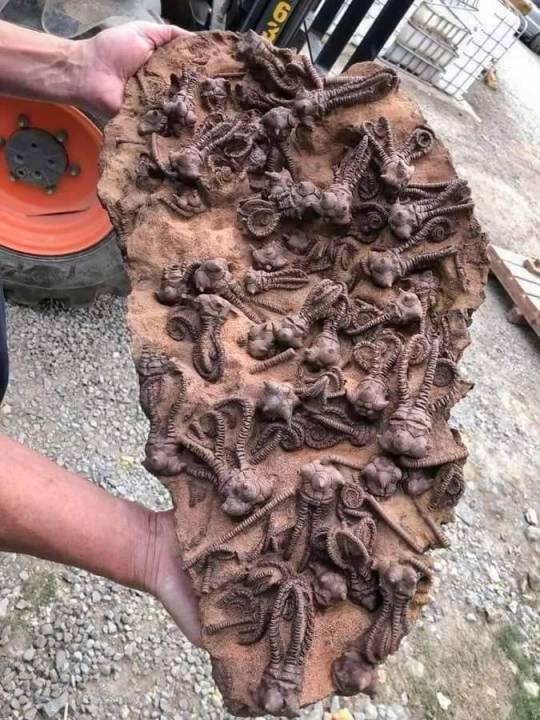
The fossils you’re seeing are from the Jimbacrinus crinoid, found in Western Australia (Gascoyne Junction), and they’re believed to be approximately 280 million years old.
These marine creatures, also known as sea lilies, lived during the Permian period. The fossils are usually found complete and have not been uncovered in any other location. They were first discovered in 1949 by the manager of Jimba Jimba cattle station, for which the genus was named.
The Permian period was the final period of the Paleozoic Era, lasting from 298.9 million to 252.2 million years ago. The climate was warming throughout Permian times, and, by the end of the period, hot and dry conditions were so extensive that they caused a crisis in Permian marine and terrestrial life.
The Permian seas were dominated by bony fishes with fan-shaped fins and thick, heavy scales. There were large reef communities that harbored squidlike nautiloids. Ammonoids, with their tightly coiled, spiral shells, are also widespread in the Permian fossil record.
Gascoyne Junction is a remote area in Western Australia known for its geological diversity. Geologists have determined that magmatic fluids came up from the earth’s mantle repeatedly over the past 1600 million years, depositing minerals along a fault line in the Gascoyne region. This area is also known for its remarkable fossil finds, including the Jimbacrinus crinoid fossils. This specimen is part of the collection at Crystal World, under the ownership of Tom Kapitany.
351 notes
·
View notes
Text

🐚 My Shell List for Ocean Witchcraft
very long!
Cowrie Shell -- Prosperity, fertility, feminine energy, wealth - where to collect: Africa, Indian Ocean beaches
Scallop Shell -- Journey, pilgrimage blessings, protection - where to collect: Atlantic beaches (USA, Europe)
Conch Shell -- Call to spirits, awakening inner power, amplifying voice - where to collect: Caribbean, warm tropical beaches
Sand Dollar -- Spiritual rebirth, peace, trust in universal cycles - where to collect: Mexico, Florida, tropical sandy shores
Murex Shell -- Royalty, sacredness, defense magic - where to collect: Mediterranean, Indo-Pacific
Olive Shell -- Grace, smooth paths, grounding wishes - where to collect: Southeastern US, Australia
Auger Shell -- Psychic defense, focus, clarity - where to collect: Indo-Pacific, Florida, warm beaches
Wentletrap Shell -- Spirit communication, delicate energy, accessing dreams - where to collect: Shallow waters, Southeast Asia
Babylon Shell -- Abundance, rootedness, wisdom of ancestors - where to collect: Persian Gulf, India, Philippines
Triton’s Trumpet -- Powerful protection, summoning sea spirits, strength - where to collect: Indo-Pacific reefs, coral-heavy shores
Limpet Shell -- Adaptability, steady progress, emotional protection - where to collect: Rocky shores, tide pools worldwide
Nerite Shell -- New beginnings, resisting negativity, safe travels - where to collect: Caribbean, Florida, Indo-Pacific
Moon Snail Shell -- Intuition, hidden wisdom, psychic dreams - where to collect: Pacific Northwest (USA), colder beaches
Top Shell -- Personal growth, creativity, positive flow - where to collect: Mediterranean, Caribbean
Turritella Shell -- Ancient memory, ancestral connection, earth-sea balance - where to collect: Fossil beds, warm shallow waters
Sundial Shell (Architectonica perspectiva) -- Cosmic connection, time magic, spiraling growth - where to collect: Indo-Pacific, sandy shallow areas
Helmet Shell (some of my favorites!) -- Courage, spiritual shielding, warrior energy - where to collect: Indo-Pacific, Caribbean
Volute Shell -- Love, devotion, honoring vows (Great gift for your partner <3) - where to collect: Warm waters, Indian Ocean
Paper Nautilus (Argonaut Shell) -- Creativity, femininity, magical flight - where to collect: These are rarer than most, and they float! Mediterranean, Australia
Angel Wing Shell -- Fragile beauty, spiritual awakening, connection to dreams - where to collect: Gulf of Mexico, Florida, Caribbean
Slipper Limpet -- Subtle healing, balance between giving and receiving - where to collect: European and East Coast shores
Donax Shell (Coquina) -- Energy shifts, playfulness, social magic - where to collect: Southeastern USA beaches
Cockle Shell -- Friendship, love, carrying home’s blessings - where to collect: European beaches, Atlantic shores
Pheasant Shell -- Endurance, adaptability, balance of inner and outer selves - where to collect: Australia, New Zealand, Pacific beaches
Spindle Shell -- Manifestation of goals, swift change, ambition - where to collect: Indo-Pacific region, tropical beaches
Marginella Shell -- Financial luck, small blessings, quick positive changes - where to collect: West Africa, Indian Ocean
Ark Shell (clam) -- Courage to face emotional challenges, opening the heart - where to collect: East Coast USA, Gulf of Mexico
Cat’s Eye Shell (Operculum) (My favorite!!!) -- Spiritual gateway, protection during astral travel - where to collect: Washed up with dead shells (Sri Lanka, Australia)
Button Top Shell -- Inner balance, softening harsh emotions, emotional maturity - where to collect: Caribbean, Indo-Pacific
✨ Tips for Collecting Shells
Respect local laws: Some places protect shells, corals, and marine wildlife! Always check if it's okay to take them.
Ethical gathering: Only take empty, dead shells (never with a creature still inside).
Cleanse shells: Wash gently with water and sea salt before using them in spells or altars.
🐚 Shell Magic Ideas
Use cowrie shells in money bowls.
Sand dollars are amazing for transformation rituals.
Conch shells can be used as literal horns to call spirits or start a ritual.
Tiny auger shells make great protection charms to wear or carry.
Paper nautilus shells (if you can find one!!) are perfect for creativity and dream weaving magic.
other sites to use: Shelling tips , shell hunting in Texas , Where and when to find shells
Note: some shells match certain moon phases! Do extra research before using, and make sure the ones you're taking aren't still alive or home to a hermit crab! that can be a miniature trouble! especially if the snail inside is possibly poisonous or venomous.
#shells#sea shells#seashells#aquatic#pagan witch#witch#witch community#witchblr#witches#witchy#witchcraft#witchy vibes#wicca#wiccan#pagan#witches of tumblr#sea witch#ocean witch#ocean witchcraft#ocean water#ocean world#ocean shells#where to find#seashell#Sand dollar#tips#cowrie#scallop#conch#sealife
29 notes
·
View notes
Photo

🍎 Natural history of New York Albany, D. Appleton & co. and Wiley & Putnam;1842-94. Original source Image description: Illustration from "Natural history of New York" (1842-94) showing detailed black-and-white sketches of seven fossilized ammonite shells and two elongated fossil shapes. The ammonites exhibit spiral patterns with various degrees of damage and internal structure exposed. Each fossil is numbered and meticulously shaded to highlight ridges, curves, and textures. The plate is titled "Upper Helderberg to Chemung Group (Goniatitidae)" and includes scientific annotations. The image visually documents ancient marine fossils, unrelated to apples, despite the keyword provided.
19 notes
·
View notes
Text
Fossil Friday: Campanile giganteum

One of our surprisingly popular March Madness competitors, Campanile giganteum is marine snail from the Paris Basin of France during the Eocene Epoch 56-33.9 Ma. It was first described by the famous Jean-Baptiste Lamarck in 1804, He initially had it in the genus Cerithium, which, to be fair, doesn't look a whole lot different.

It was found in the Lutetian limestone (Calcaire lutecian) also known as the Paris Stone. This formation consists of a freshwater limestone deposited on top of a marine limestone as well as some minor calcareous and glauconitic sandstones. This suggests an open, shallow subtidal zone.
This giant snail lived alongside other invertebrates like foraminiferans,

a bivalve called Crassatella,
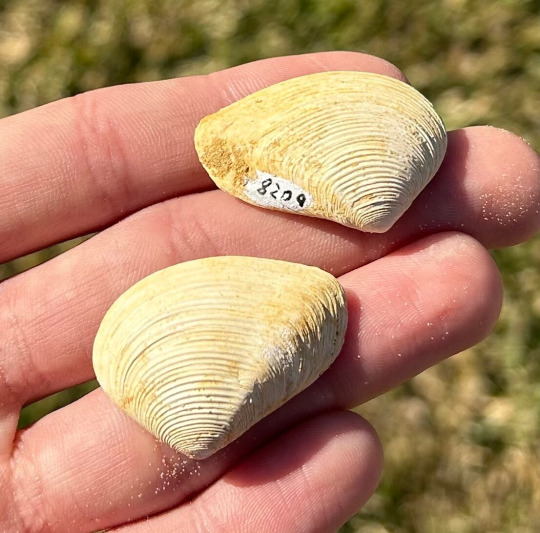
other snails,
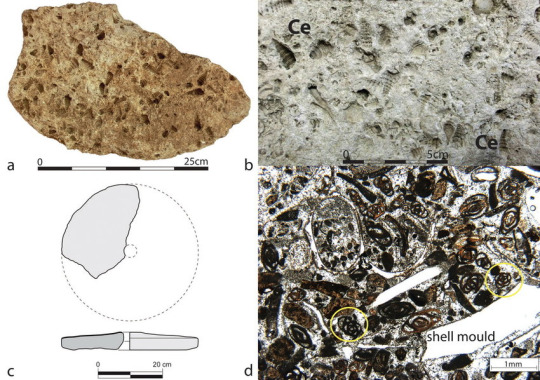
and marine worms.
C. giganteum is actually only one species of many within the genus Campanile. it belongs in the phylum Mollusca which includes snails, cephalopods and bivalves.
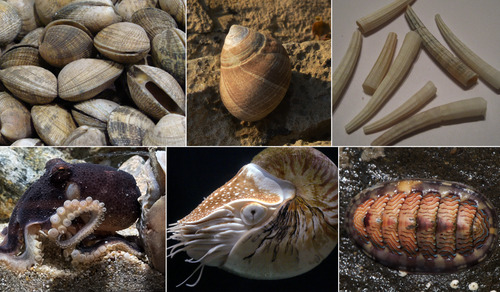
From there they belong in the class gastropoda, commonly known as snails and slugs.

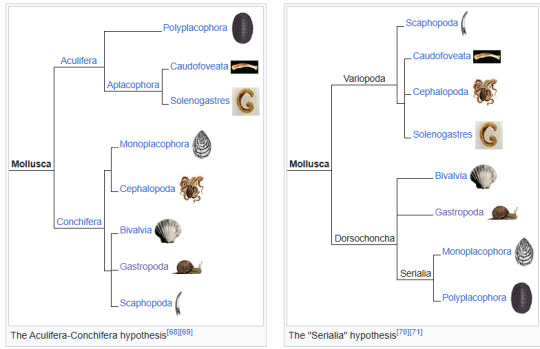
There's currently a bit of debate going on with taxonomy further down, but there are at least 18 named species of Campanile including one living species C. symbolicum whose common name is the Bell Clapper or Giant Creeper. It lives in coastal waters off southwestern Australia.
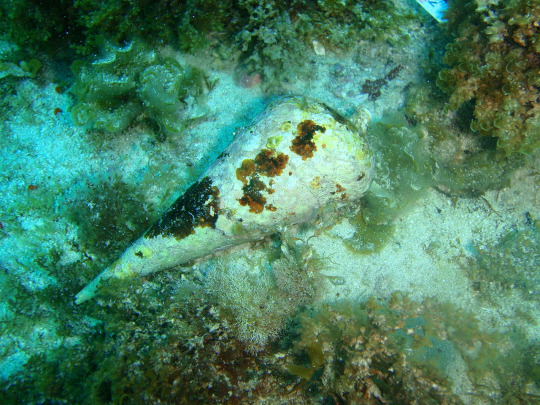
C. giganteum was the largest gastropod to have lived (as far as we know). It got up to 35 in (90cm) on average. C. symbolicum only gets to a little less than 10 inches (24 cm).
A study was done in 2020 on C. giganteum in regard to growth and paleoseasonality. They found that C. giganteum grew upwards of 600 mm per year along the helix of their shell. They concluded that it lived in water between 21-32 degrees Celsius (69.8-89.6 degrees F) which really isn't all that different from the Mediterranean Sea today (a little warmer). If you want to read more about this study, here's the link:
https://agupubs.onlinelibrary.wiley.com/doi/full/10.1029/2019GC008794
Make sure you tune in Monday as we talk more about different types of igneous rocks! Fossilize you later!

26 notes
·
View notes
Text
🧜🏾♂️Subtle Triton Worship 🐚
Blow into a conch shell, especially when by the ocean or a body of water
Clean up trash by the ocean shore or any body of water
Go swimming, especially in the ocean; play pool games
Go diving (Safely, please)
Get a candle that reminds you of him; no altar needed
Wear jewelry that reminds you of him
Keep a picture of him in your wallet
Help any beached sea creature you stumble across (Or any fish that wash up on a lake and are alive)
Learn about the invasive species in any bodies of water in your area; advocate for their removal, and remove them if you come across any (And are able to do so safely)
Collect any seashells or pretty stones you come across near water
Have a fish, dolphin, horse, or crab stuffed animal
Have imagery of the ocean (especially the deep sea), conch shells, tridents, sea creatures/plants, and merfolk (especially those with two tails or dolphin tails) around
Try eating seafood or seaweed (Be aware that many people are often allergic to shellfish!!! Shrimp, crabs, lobsters, etc.)
Keep a pet fish or water dwelling creature; be sure to research the animal first to ensure quality of life under your care
Stay hydrated; drink lots of water throughout the day
Drink warm water with honey stirred in
Donate to or support ocean/river/lake-focused organizations or animal shelters
Learn about the deep sea marine life; learn about any form of marine life
Go sailing, paddle boarding, kayaking, etc. (Safely)
If you don't know how to swim, take swimming lessons or have someone teach you; always wear a lifejacket or floaties for your safety, until you feel comfortable with your skill
Practice asserting yourself and standing your ground; do your best to assert your personal boundaries; take time to learn what your boundaries are if you aren't sure
Take a warm shower/bath when you feel overwhelmed; use the water to cleanse and relax you
Leave a glass of water on your windowsill for the night or day; either replace or drink it after a few hours (you don't need to have water there constantly, it's just a once in a while thing)
Keep a jar of seaglass; make art from it or simply put it in the light, it'll look great either way
Collect ethically sourced shark teeth; collect ethically sourced fossils of ocean creatures
Learn to play the trumpet, trombone, French horn, or other brass instrument
Embrace your inner strength; celebrate how far you've come and how resilient you are
Ground yourself near a body of water, particularly the ocean; allow yourself to be one with the waves or subtle ripples of water; match your breath to the tide if you can
Fall asleep/meditate to the sound of ocean waves or sea creatures
Wash your hands/face with salt water
Dance/sing to music that makes you feel empowered or badass
-
This one was definitely tough because I struggled to find historical accounts of Triton being worshipped. Typically, I can draw some ideas from that if I'm not familiar with a deity, but Triton didn't have many records of worship, despite being widely accepted as Poseidon and Amphitrite's son. He was mostly known as Poseidon's herald, and in some accounts, he was even Athena's foster parent, yet there is still such little information about him to be found.
At least for now, this is my list of discreet ways to worship Triton. I hope to be able to add more in the future, and I hope that it's still helpful to people as is. Take care, y'all, and chill with the waves. 💚
Link to Subtle Worship Master list
#helpol#hellenic polytheism#hellenic pagan#triton deity#triton#triton worship#deity worship#paganblr#ocean deities#paid for by a generous donor 💚
79 notes
·
View notes
Text
Taxonomy Tournament: Cephalopod Finale!
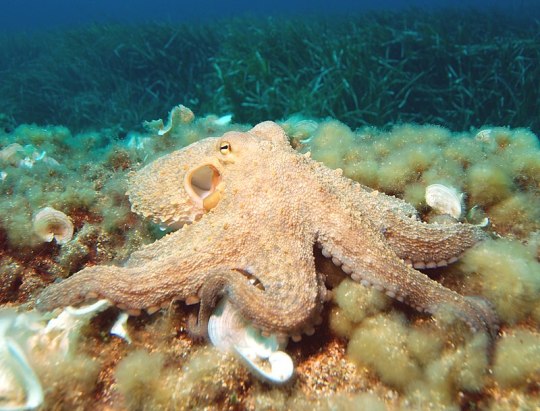
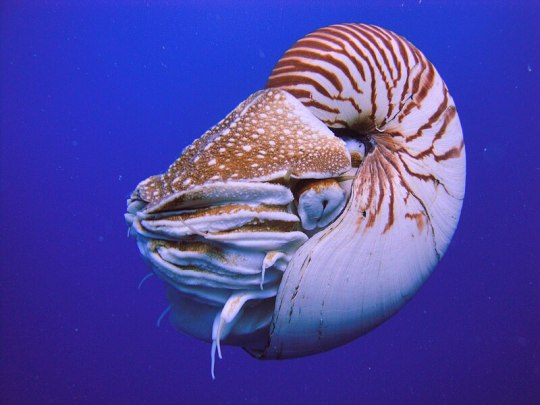
Octopoda. This order is made up of octopuses, predatory marine creatures with eight limbs. Their soft body allows them to squeeze trhough small spaces. They are capable of camouflage and are among the most intelligent animals.
Nautilida. This order is made up of nautilis, which have a unique planispiral shell, and move via jet propulsion. They're morphologically veyr similar to their ancient relatives, and are often called living fossils.
#animals#biology#polls#poll tournament#zoology#octopus#octopi#octopuses#molluscs#cephalopods#spiralia#nautilis#Octopoda#Nautilida#0x15v0x2a
123 notes
·
View notes